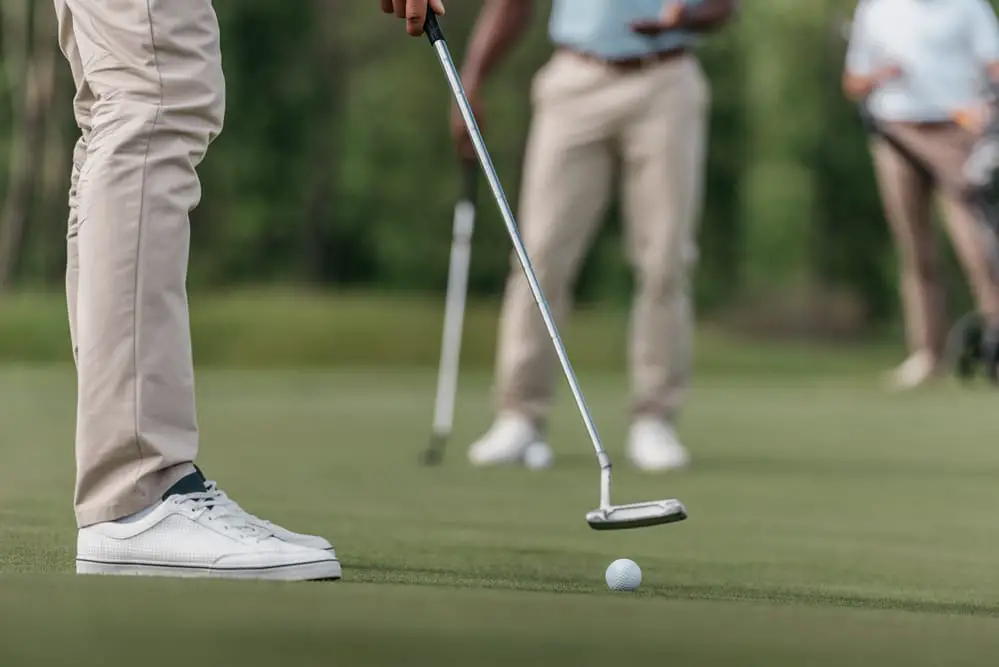Last Updated on November 8, 2023
Golfers everywhere know that an eagle in golf is a great achievement, but what does it mean, and how can you score one? It’s not as hard as you think. Scoring an eagle requires skill and practice. In this blog post, we’ll explain exactly what an eagle is in golf, how to score one, and the benefits of doing so. Plus, some handy tips on achieving success with your next tee shot. So if you’re looking to up your game with a little extra knowledge about eagles in golf, then look no further.
Table of Contents:
- What Is an Eagle?
- How to Score an Eagle
- The Benefits of Scoring an Eagle
- Tips for Scoring an Eagle
- Conclusion
What Is an Eagle?
An eagle is a score of two strokes under par on a single hole in golf. It is the second-best score that can be achieved on any given hole, with only a hole-in-one being better. An eagle usually occurs when an exceptionally skilled golfer hits their tee shot close to the pin and then sinks the putt for birdie.
Eagles are relatively rare occurrences, as they require skilful play from both long and short distances. Even professional golfers rarely achieve an eagle during competition, so it’s considered quite an accomplishment when one does occur. The term “eagle” comes from the fact that eagles are large birds of prey which soar high above other birds – similarly, scoring an eagle requires players to hit shots higher than those required for par or birdie scores.
When playing at a course with multiple par fours and fives, achieving even one eagle can significantly improve your overall scorecard for the round – sometimes making all the difference between winning or losing. As such, many golfers strive to make eagles part of their game plan whenever possible.
How to Score an Eagle
Scoring an eagle is a feat that requires precision and skill. It’s not easy to achieve, but it can be done with the right technique and practice.
The first step in scoring an eagle is hitting your tee shot onto the green. This requires accuracy as you need to hit your ball close enough to the hole so that you have a chance of sinking it in two shots or less. If you can get on the green, then you will have more control over where your ball goes next.
Once on the green, it’s important to read the terrain carefully before taking your second shot. You should look for any breaks or slopes to determine which direction your putt should go in order for it to reach its destination – i.e., into the cup. Make sure that when putting, you take into account how fast or slow each stroke needs to be depending on how far away from the hole you are; if too much power is used, then there’s a risk of missing altogether.
When attempting an eagle putt, ensure that all other players stand still until after yours has been taken; this will ensure no distractions occur during what could potentially be one of golf’s most rewarding moments. Also, remember not to rush yourself – take time between each shot so as not to become overwhelmed by pressure or nerves when playing such a difficult game like golf.
Finally, don’t forget about practising regularly – even if just at home using a practice net – as this will help improve accuracy and consistency when trying for an eagle out on the course. With regular practice comes confidence and understanding of what works best for individual players; use these skills wisely when aiming for those elusive eagles.
The Benefits of Scoring an Eagle

Scoring an eagle is one of the most satisfying accomplishments in golf. It’s a great feeling to see your scorecard with a big ‘E’ on it, and it can give you a huge boost of confidence that will help you lower your overall score for the round.
An eagle is when you hit two strokes under par on any given hole. For example, if the hole has a par-4 rating, then scoring an eagle would mean hitting the ball into the cup in just two shots instead of four. This means that while other players struggle to make par or even bogey (one stroke over par), you’ve already moved on to the next hole.
The benefits of scoring an eagle don’t end there either; it looks great on your scorecard too. A single ‘E’ stands out from all those pars and bogies and shows everyone who sees it that you can play at a higher level than most golfers. Plus, since eagles are so rare, they also make for great stories around the clubhouse after your round is done – bragging rights galore.
However, despite its many advantages, scoring an eagle isn’t always easy to do consistently. You need to have good technique as well as an accurate judgement about distance and club selection to pull off this feat regularly. Common mistakes include misjudging distances or selecting clubs which aren’t suitable for certain situations – these can easily lead to double bogeys or worse if not corrected quickly enough during play.
To increase your chances of getting an eagle more often, here are some tips: Firstly, practice accuracy by using shorter clubs such as wedges rather than drivers whenever possible. Secondly, take time to judge distances accurately before each shot. Thirdly, focus on maintaining balance throughout the swing. Finally, try visualising where exactly you want the ball to land before making contact with it; this will help improve accuracy over time.
By following these simple steps and putting in some extra practice sessions at home or at driving ranges, soon enough, scoring eagles won’t be such a rarity anymore but something that happens quite frequently during rounds. Enjoy every moment when it does happen because they are special moments indeed.
Tips for Scoring an Eagle
It’s an impressive feat that requires skill and precision, but it’s not impossible to achieve. To increase your chances of scoring an eagle, you need to practice your short game and be familiar with the layout of the hole before teeing off.
Wind speed and direction are important factors when hitting your tee shot, as they can determine where the ball lands on the green. Aim for a spot that gives you a good chance at sinking the putt in two shots or less. This will give you more room for error if something goes wrong during your approach shot or putting stroke.
It’s also helpful to know how far away from the pin each club in your bag can hit so that you have better control over where it lands on the green. Knowing this information allows you to pick which club is best suited for different situations depending on wind conditions, terrain, etc., giving yourself a better chance at getting close enough for an eagle putt attempt.
When playing around hazards such as bunkers or water features, try using higher lofted clubs like wedges instead of longer irons so that there’s less risk involved with missing them completely and ending up out-of-bounds or worse yet in one of those hazards. If possible, lay up near these obstacles rather than trying to go straight over them since this will help keep things safer while still leaving yourself with a manageable distance left into the green for an eagle opportunity.
Finally, don’t forget about course management when attempting eagles; make sure that all other players in your group know what kind of shot you’re going for so they don’t get too close while waiting their turn. Being mindful of safety first should always be priority number one, no matter what type of scorecard goal we might have set our sights upon.
Conclusion
Scoring an eagle in golf is a great way to improve your game and impress your friends. With the right knowledge, practice, and skill, you can achieve this goal. An eagle is not only impressive but also rewarding, as it will help you lower your score and increase your confidence in the course. Remember that even if you don’t get an eagle every time, having fun while playing golf should always be the main focus of any round.


